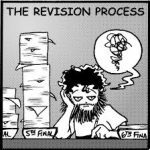Coming Up Short
 Kaitlyn Dunnett/Kathy Lynn Emerson here, bemoaning the fact that I’ve made it through the last chapter of the second draft of the first book in a new cozy mystery series . . . and I’m still 12,000 words short of the minimum length my publisher requires.
Kaitlyn Dunnett/Kathy Lynn Emerson here, bemoaning the fact that I’ve made it through the last chapter of the second draft of the first book in a new cozy mystery series . . . and I’m still 12,000 words short of the minimum length my publisher requires.
Oops.
Now I should point out that I write multiple drafts of every book, with long breaks to let the writing “gel” between revisions, and that each of my drafts tends to be longer than the previous one. However, twelve thousand words—that’s roughly fifty typewritten pages—is a pretty big gap at this stage, even for me. To tell you the truth, I’m a little worried. You see, as far as I can tell, I’ve covered all the plot points I need to, I’ve done as much character development as is necessary to make these people believable, and I’ve successfully planted all my clues and red herrings. I could be wrong—my judgment may be off, since I’m so close to the project—but assuming that I’m not, I’m in a bit of a pickle.
 My contract says I owe the publisher a novel running somewhere between 75,000 and 100,000 words. The only way 63,000 words would make the cut is if every page had lots and lots of “white space” and although I do write some dialog in short, pithy single sentences, that’s not really my style, let alone the style of the characters.
My contract says I owe the publisher a novel running somewhere between 75,000 and 100,000 words. The only way 63,000 words would make the cut is if every page had lots and lots of “white space” and although I do write some dialog in short, pithy single sentences, that’s not really my style, let alone the style of the characters.
Padding for the sake of word count is also out. You might remember the song, “The Book Report” from the musical You’re a Good Man, Charlie Brown. Lucy has 95 words. She needs 100. She writes: “The very, very, very end.” This is obviously not a good solution, no matter how long the piece of writing.
So where am I going to find all those additional words? Good question.
 Some will come naturally when I do the next pass, what I call a “read thru/revision” of the whole manuscript. My rough (first) draft came out to a little over 50,000 words. So, yes, I added 13,000 words when I revised, but no way can I add another 12,000 words to my opus by adding more descriptive details and replacing vague words with specific ones. Even finding areas that need a bit more exposition to clarify what is going on won’t help much.
Some will come naturally when I do the next pass, what I call a “read thru/revision” of the whole manuscript. My rough (first) draft came out to a little over 50,000 words. So, yes, I added 13,000 words when I revised, but no way can I add another 12,000 words to my opus by adding more descriptive details and replacing vague words with specific ones. Even finding areas that need a bit more exposition to clarify what is going on won’t help much.
Fortunately I have some time before the book is due. One obvious solution is to add a second subplot, or perhaps simply enlarge upon the subplot I already have. Here’s the set up: Mikki Lincoln, a woman my age (or, at least she was my age when I originally wrote the proposal—now she’s a couple of years younger than I am!) has been happily living in Maine with her husband for the last forty-plus years. When she’s widowed, she decides on impulse to move back to her old home town in New York’s Catskill Mountains after fifty years away. The trigger for this drastic step was finding a listing for her childhood home in the real estate ads. When the book opens, she and her cat have moved into this house and Mikki is worrying about how she’s going to pay for the extensive repairs it needs. Then she has an idea. She’s a retired English teacher. Why not set up shop as a freelance editor—a book doctor? Cut to a couple of months later, when this plan seems to be going well . . . until one of Mikki’s first clients ends up dead. Solving the murder, of course, is the main plot. The subplot deals with Mikki adjusting to old friends and old stomping grounds that have undergone some pretty drastic changes in half a century.
 I have had one idea for a new scene. It revolves around the requirement that Mikki get a new driver’s license and license her car in New York State. I see the experience as having humorous elements. Now all I have to do is figure out how it can also advance the main plot. Maybe not every single word of the 75,000 has to push forward toward the solution of the crime—some can simply develop character—but I can’t just throw a scene in for the heck of it, either.
I have had one idea for a new scene. It revolves around the requirement that Mikki get a new driver’s license and license her car in New York State. I see the experience as having humorous elements. Now all I have to do is figure out how it can also advance the main plot. Maybe not every single word of the 75,000 has to push forward toward the solution of the crime—some can simply develop character—but I can’t just throw a scene in for the heck of it, either.
If I do write that scene, it will run 1000-1500 words. That will still leave me way short of what I need. I guess the real question I’m asking myself at this stage is what is padding and what is not. Obvious information dumps are out, but what about reminiscences?
I’ve already included quite a few glimpses of Mikki’s past, as well as a number of scenes with her cat, Calpurnia. Mikki talks to the cat. The cat does not talk back. There are also a few scenes with Mikki editing manuscripts. I’ve gone lightly on the details, save for mentioning the occasional pet peeve, because I’m leery of overdoing this.

The real “Calpurnia”
What do you think, those of you reading this blog? What do you like to find included in a cozy mystery, aside from the mystery itself? Do you enjoy reading lots of character backstory? Do you want a hint of romance? What about details of the protagonist’s profession—how much is too much? Any and all comments will be much appreciated.
 Kathy Lynn Emerson/Kaitlyn Dunnett is the author of over fifty books written under several names. She won the Agatha Award for best mystery nonfiction of 2008 for How to Write Killer Historical Mysteries and was an Agatha Award finalist in 2015 in the best mystery short story category for “The Blessing Witch.” Currently she writes the contemporary Liss MacCrimmon Mysteries (Kilt at the Highland Games) as Kaitlyn and the historical Mistress Jaffrey Mysteries (Murder in a Cornish Alehouse ~ UK in December 2016; US in April 2017) as Kathy. The latter series is a spin-off from her earlier “Face Down” series and is set in Elizabethan England. Her websites are www.KaitlynDunnett.com and www.KathyLynnEmerson.com
Kathy Lynn Emerson/Kaitlyn Dunnett is the author of over fifty books written under several names. She won the Agatha Award for best mystery nonfiction of 2008 for How to Write Killer Historical Mysteries and was an Agatha Award finalist in 2015 in the best mystery short story category for “The Blessing Witch.” Currently she writes the contemporary Liss MacCrimmon Mysteries (Kilt at the Highland Games) as Kaitlyn and the historical Mistress Jaffrey Mysteries (Murder in a Cornish Alehouse ~ UK in December 2016; US in April 2017) as Kathy. The latter series is a spin-off from her earlier “Face Down” series and is set in Elizabethan England. Her websites are www.KaitlynDunnett.com and www.KathyLynnEmerson.com



